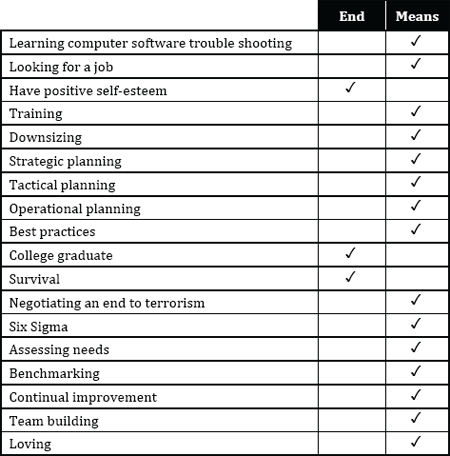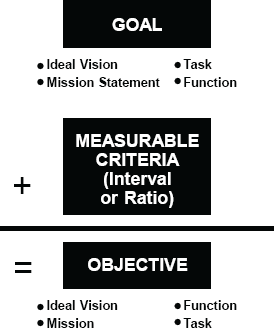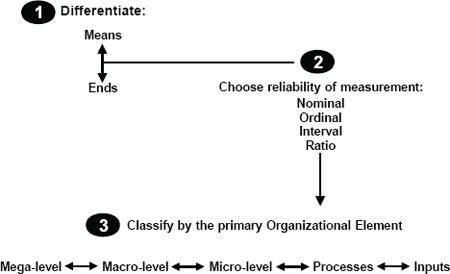Means vs. Ends Answer Key

Just because something is important doesn’t mean that it is an end. Negotiating an end to terrorism is a means we all want to be successful but the means of negotiating is not the same as getting the terrorism to end. Similarly, training can be a means to get useful competence and successful performance—an end that is useful. We should not confuse any “how” (a means) with the results, or ends. One verbal cue that you might be dealing with a means is that just about all words in the English language ending with “ing” (planning, developing, evaluating, learning, training, managing, creating) are means. To find out what ends might be related, simply ask, “If we were successful with this means, what would the result be?”
There is no such thing as something that is not measurable. Objectives at all levels of planning, activity, and results are vital for valid planning. Everything is measurable—measurable on a mathematical scale of measurement (Table 5.1)—so don’t deceive yourself into thinking you can dismiss important results as being “intangible” or “not measurable.” Doing so denies you the ability to measure your success, failure, or progress toward useful results.
Just saying something is “not measurable” is in itself a measurement: you have distinguished two categories. It is only sensible and rationale to make a commitment to measurable purposes and destinations. Increasingly, organizations throughout the world are increasingly focusing on Mega-level results.5
Goals and objectives are related yet different. There are differences between goals and objectives, and regardless of the level—Mega, Macro, Micro—they all should be rigorous and measurable, as shown in Figure 5.3.
Figure 5.3. The relationship between goals and objectives and their characteristics.6
For example, a goal might be “improve the profits of our organization.” Adding Interval or Ratio scale criteria would add the criteria to change it to an objective of “increase profits by at least 10% a year for five consecutive years.” The goal notes “where we are headed,” and the objective precisely adds “how we know when we have arrived.”
So no matter whether you are preparing objectives for the societal/Mega level, for the organizational/Macro level, or for the individual performance/Micro level, you should be precise and rigorous: state measurably where you are headed and how you can tell when you have arrived.
A goal (or aim or purpose) states where we are headed but does not have rigorous criteria for measuring the accomplishment. An objective states both where you are headed and how to precisely tell when you have arrived. The more we state our purposes as objectives, the more confidence we can have of assuring completion of what we deliver.
Ensuring that you have the required characteristics of an objective. To check on your relating ends, means, measurability levels, and the Organizational Elements, Figure 5.4 shows a way to see where you are relative to all of this as shown in an activities progression.
We have been moving along in defining where we should head, based on the Ideal Vision, and the importance of measurable rigor. Now, let’s turn our attention to some guides and tools to use as we think and apply Mega.
Figure 5.4. The relationship among ends and means, reliability of measurement, and Organizational Element focus.


